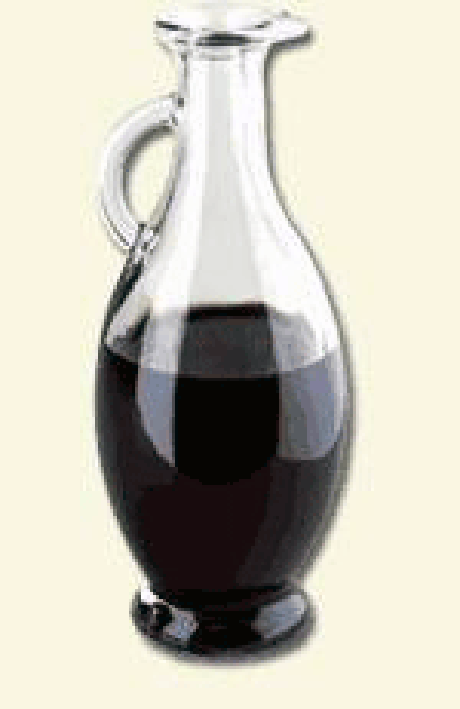 Balsamic vinegar in a pouring jug.
Balsamic vinegar in a pouring jug.
Welcome to the summary page for FabulousFusionFood's Cook's Guide entry for Balsamic Vinegar along with all the Balsamic Vinegar containing recipes presented on this site, with 0 recipes in total.
This is a continuation of an entire series of pages that will, I hope, allow my visitors to better navigate this site. As well as displaying recipes by name, country and region of origin I am now planning a whole series of pages where recipes can be located by meal type and main ingredient. This page gives a listing of all the Balsamic Vinegar recipes added to this site.
These recipes, all contain Balsamic Vinegar as a major wild food ingredient.
Balsamic vinegar is a highly-flavoured vinegar prized by chefs and foodies. It is commonly used in Italian cuisine and in Italian it is called aceto balsamico It is a traditional product originating in Modena, where it has been made since the Middle Ages and some of the names (notably: "Aceto Balsamico Tradizionale di Modena") are protected by the Denominazione di Origine Controllata and the European Union's Protected designation of origin. Unlike common vinegars, it is dark and thick with a complex, sweet taste and much more expensive.
Only two consortia produce 'proper' balsamic vinegar: Modena and Reggio Emilia. Modena designate the different ages of their balsamic vinegar by label colour. A red label means the vinegar has been aged for at least 12 years, a silver label that the vinegar has aged for at least 18 years and a gold label that designates the vinegar has aged for 25 years or more. Reggio Emilia (Aceto Balsamico Tradizionale de Reggio Emilia) uses a similar system to indicate the age of their balsamic vinegars. A white label means the vinegar has aged for at least 12 years and a gold label bearing the designation extravecchio to show the vinegar has aged for 25 years or more.
Balsamic vinegar is manufactured from the juice of white grapes (typically, trebbiano grapes) boiled down to approximately 50% of its original volume to create a concentrated must, which is then fermented with a slow ageing process which concentrates the flavours. The flavour intensifies over decades, with the vinegar being kept in fine wooden casks, becoming sweet, viscous and very concentrated (what is gone is romantically referred to as "the angels' share".
This is a continuation of an entire series of pages that will, I hope, allow my visitors to better navigate this site. As well as displaying recipes by name, country and region of origin I am now planning a whole series of pages where recipes can be located by meal type and main ingredient. This page gives a listing of all the Balsamic Vinegar recipes added to this site.
These recipes, all contain Balsamic Vinegar as a major wild food ingredient.
Balsamic vinegar is a highly-flavoured vinegar prized by chefs and foodies. It is commonly used in Italian cuisine and in Italian it is called aceto balsamico It is a traditional product originating in Modena, where it has been made since the Middle Ages and some of the names (notably: "Aceto Balsamico Tradizionale di Modena") are protected by the Denominazione di Origine Controllata and the European Union's Protected designation of origin. Unlike common vinegars, it is dark and thick with a complex, sweet taste and much more expensive.
Only two consortia produce 'proper' balsamic vinegar: Modena and Reggio Emilia. Modena designate the different ages of their balsamic vinegar by label colour. A red label means the vinegar has been aged for at least 12 years, a silver label that the vinegar has aged for at least 18 years and a gold label that designates the vinegar has aged for 25 years or more. Reggio Emilia (Aceto Balsamico Tradizionale de Reggio Emilia) uses a similar system to indicate the age of their balsamic vinegars. A white label means the vinegar has aged for at least 12 years and a gold label bearing the designation extravecchio to show the vinegar has aged for 25 years or more.
Balsamic vinegar is manufactured from the juice of white grapes (typically, trebbiano grapes) boiled down to approximately 50% of its original volume to create a concentrated must, which is then fermented with a slow ageing process which concentrates the flavours. The flavour intensifies over decades, with the vinegar being kept in fine wooden casks, becoming sweet, viscous and very concentrated (what is gone is romantically referred to as "the angels' share".
The alphabetical list of all Balsamic Vinegar recipes on this site follows, (limited to 100 recipes per page). There are 0 recipes in total:
Page 1 of 1
Page 1 of 1